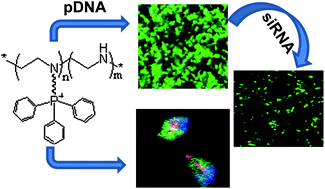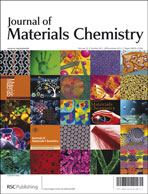Lipophilic and cationic triphenylphosphonium grafted linear polyethylenimine polymers for efficient gene delivery to mammalian cells†
Abstract
Synthetic chemical vectors have recently provided a versatile and robust platform for the safe and efficient delivery of exogenous genes. Here, for the first time, a small series of N-butyltriphenylphosphonium bromide-grafted-linear polyethylenimine (BTP-g-lP) polymers (N–P hybrid polymers) have been evaluated for their ability to deliver genes into mammalian cell lines, viz., MCF-7 and A549 cells. Biophysical characterization revealed that the projected polymers efficiently interacted with plasmid DNA, and the resulting complexes displayed hydrodynamic diameters in the range of 249–307 nm with relatively higher zeta potential values of +31 to +34 mV (cf. lPEI, +26 mV). The tethering of lipophilic and cationic triphenylphosphonium moieties to linear PEI (lPEI) addressed several limitations associated with lPEI, such as solubility, the stability of the pDNA complexes and the timely release of pDNA for nuclear localization as assessed by protection and release assays. Also, the lipophilic interactions between cellular membranes and the pDNA complexes mediated the efficient cellular uptake and internalization of the pDNA complexes, resulting in significantly higher transfection efficiency in these cell lines, outperforming the GenePORTER 2™, Lipofectamine™ and Superfect™ used in the study for comparison purposes. Confocal studies using dual-labeled TMR-BTP-g-lP3/YOYO-1-pDNA complex in MCF-7 cells confirmed that the complex behaved more or less like native lPEI, as the substitution of the phosphonium moiety was too small to affect the intracellular trafficking. Furthermore, the versatility of the BTP-g-lP3 vector was established by GFP specific siRNA delivery, which resulted in ∼79% suppression of targeted gene expression (cf. Lipofectamine™, ∼55%). Altogether, the study demonstrates the potential of these hybrid polymers for the efficient delivery of nucleic acids for future gene therapy applications.


 Please wait while we load your content...
Please wait while we load your content...